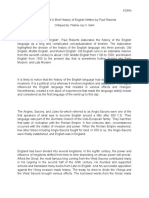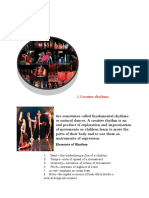04 Handout 1 PDF
04 Handout 1 PDF
Uploaded by
Elaine SorianoCopyright:
Available Formats
04 Handout 1 PDF
04 Handout 1 PDF
Uploaded by
Elaine SorianoOriginal Title
Copyright
Available Formats
Share this document
Did you find this document useful?
Is this content inappropriate?
Copyright:
Available Formats
04 Handout 1 PDF
04 Handout 1 PDF
Uploaded by
Elaine SorianoCopyright:
Available Formats
SH1689
Ballroom Dance
I. Types of Ballroom Dance
There are two (2) main styles of ballroom dancing – American and International. American
style is danced primarily in the USA. It is also not as standardized as international style, which
is performed and known worldwide. Moreover, there are two (2) categories under each style.
These are listed below in the order that they are danced in competitions.
A. American Style
• Smooth –Waltz, Tango, Foxtrot, Viennese Waltz
• Rhythm – Cha Cha, Rumba, East Coast Swing, West Coast Swing, Bolero, Mambo,
Samba
B. International Style:
• Standard – Waltz, Tango, Viennese Waltz, Foxtrot, Quickstep
• Latin – Cha Cha, Samba, Rumba, Paso Doble, Jive
II. Origins of Ballroom Dance
Ballroom dancing is when a couple performs any of the various social dances that follow a
pattern of predictable steps. It has an immensely amplified popularity spreading across Europe,
the Americas, and Asia. Ballroom dancing has a relatively short but interesting history and has
evolved from a recreational activity to a worldwide sporting event.
Ballroom dancing originated in England in the late 18th and early 19th centuries in which these
dances, such as the waltz, were performed by the upper and elite classes of society in balls and
parties. During the late 19th to the early 20th centuries, it became a trend among the working
and middle class where they would go to gatherings and events in public dance halls. In the
early 1920s, ballroom dancing competitions started to boom, an organization called The
Ballroom Branch of the Imperial Society of Teachers of Dancing was formed. The objective
of this organization was to standardize and formalize ballroom dancing techniques, sets of
steps, and music to which it was danced to.
In legitimate dance sport competitions and in social events, there are five (5) standard dances.
These are (1) Modern Waltz; (2) Viennese Waltz; (3) Tango; (4) Slow Foxtrot; and (5)
Quickstep. These dances are standardized and categorized into segregated teaching levels and
utilize vocabulary, rhythm and tempo, and techniques which are accepted internationally.
Although these dances come from very different backgrounds and have special techniques,
aesthetics, and rhythms and tempos, they do share common qualities. All ballroom dances, as
with all forms of dance, are expressions of feelings, thoughts, and emotions. These dances may
be stricter than other forms of dance and may limit the range of steps and body movement
involved, but it is still one of the best expressions of love, joy, and pain between two (2) people.
Also, all ballroom dances are performed by only two (2) people, usually a man and a woman.
These dances are performed in a certain position termed as the “closed hold.” In this position,
the couple strictly remains in contact in five (5) different points or places. These five (5) points
consist of three (3) hand contacts, one (1) elbow contact, and one (1) chest contact.
• First-Hand Contact – This occurs when the man’s left hand holds the lady’s right hand.
• Second-Hand Contact – This occurs when the lady’s left hand is placed at the top of the
man’s right upper arm. In tango, the lady’s left hand is placed behind the man’s arm, not
on top of it.
04 Handout 1 *Property of STI
Page 1 of 3
SH1689
• Third-Hand Contact – This occurs when the man’s right hand is placed under the left
shoulder blade on the lady’s back.
• Elbow Contact - This occurs when the lady’s left elbow rests on the man’s right elbow
and both arms are kept in a horizontal line. The lady’s arms are held comfortably by the
man and permit her to follow the man’s lead with ease. This also gives the couple the
appearance of having a bearing of royalty. This is an important characteristic in the
ballroom dances that came from Western Europe because these dances were performed in
the royal courts.
• Chest Contact – This last point of contact occurs when the right area of the chest of one
(1) touches almost the right area of his/her partner. This closeness allows very little room
between the partners’ faces thus contributing to the dance’s romantic appeal.
III. Evolution of the Different Types of Ballroom Dance
A. Waltz
The waltz is probably the oldest extant ballroom dance, not including the medieval re-
enactment of court dances, still regularly performed today. Set to 3/4 time, it was too
scandalous for the French court due to the close embrace that it required. King Louis XIII
actually banned the dance from his court. Like most legislated morality, the law failed to
quell the act and the dance survived and spread. The dance halls in Vienna sped up the
tempo and gave the world the intense and whirling Viennese waltz, and composers such
as Johann Strauss Jr. became famous for the music they composed for the dance.
B. Tango
In the Latin world, the Spanish explorers brought flamenco with them to the new world.
As it melded with slave dances from Africa and Central American cultures, it became
known as the tango, with a particularly sensual variant becoming popular in Argentina.
Traveling back across the Atlantic to France in 1910, it became popular through Europe
and America and further.
C. Foxtrot and Quickstep
Not all ballroom dances have such murky beginnings. The Foxtrot, for example, came
quite simply from a popular performer in 1913, Harry Fox. The "trot" part of the name is
a little confusing, as the dance is characterized by a very smooth yet sauntering basic step.
In social dancing, this is also known as the slow foxtrot to differentiate it from the
quickstep, another variant with the same roots.
D. Rhythmic Latin Dance
The roots of the Latin or Rhythm dances are a more tangled morass of traditions and
popular culture. Although similar in some aspects, each of these dances still has a distinct
style of its own.
E. Mambo and Cha Cha
The mambo came from Cuba and has a very clear originator, Perez Prado, who developed
the mambo style of music in 1943. However, that style of music itself was based on a
rumba beat with a slightly different ending, and mambo was done with an emphasis on a
different beat. As the mambo became too difficult for nearly anyone other than the
professional ballroom dancers, it metamorphosed into the cha cha.
F. Rumba
The rumba beat had its own dance that was known by various names including Son and
Danzon. However, rumba is the name that stuck and the dance became a sensual writhing
staple of ballrooms across the world.
04 Handout 1 *Property of STI
Page 2 of 3
SH1689
G. Samba
It is also known as the Brazilian waltz. A cross-blending of African tribal dance and
traditional Brazilian moves, it became the featured dance for the wild revelry of Carnival,
accompanied by the pounding beats of the bateria or drum corps.
H. Bolero and Paso Doble
Both the bolero and paso doble are of Spanish origin, although the paso doble developed
in France. They are highly stylized dances based on older forms of dance such as the
flamenco and the fandango and are danced more often by professional competitors than
social dance enthusiasts.
I. Swing
The swing dance comes in several varieties. The two (2) primary versions are east coast
swing and west coast swing, both of which originated in the American heartland and spread
in opposite directions during the era of World War II. Like the waltz of centuries ago, this
kind of dance was deemed immoral, and therefore exploded in popularity with the young,
hip dancers all over the world. Today, swing is still performed in clubs and dance halls all
around the world.
IV. Benefits of Ballroom Dancing to One’s Health
A. Mental
• It helps to improve mental acuity by requiring split-second rapid-fire decision making.
• It can stimulate the connectivity of the brain by generating the need for new neural
pathways.
• It simultaneously involves kinesthetic, rational, musical, and emotional processes.
B. Physical
• Flexibility – Most forms of dance require dancers to perform moves that require
bending and stretching, so dancers naturally become more flexible simply by dancing.
• Endurance – Regular dancing is great for improving endurance and overall health.
Elevating the heart rate through vigorous ballroom dancing can increase stamina. Just
as in any form of exercise, regular dancing will build endurance.
C. Well-being
• It provides many opportunities to meet other people. Joining a dance class can increase
self-confidence and build social skills. And, because physical activity reduces stress
and tension, regular dancing gives an overall sense of well-being.
• It burns calories and can assist in weight loss. Dancing burns anywhere from 5-10
calories per minute, depending on speed and intensity.
Approximate Calories Burned per Hour
Style of Dance 100 lb. 125 lb. 150 lb. 175 lb. 200 lb.
Dancer Dancer Dancer Dancer Dancer
Disco Ballroom, Square, Latin,
264 330 396 462 528
Mambo, Salsa
Fast, Ballet, Twist 288 360 432 504 576
Slow, Waltz, Foxtrot 144 180 216 252 288
References:
History of ballroom dancing. (n.d.). Retrieved from http://dance.lovetoknow.com/
Origins of ballroom dancing. (n.d.). Retrieved from http://www.montrealballroomdancing.com/
Types of ballroom dancing. (n.d.). Retrieved from http://www.justdanceballroom.com/styles.html
04 Handout 1 *Property of STI
Page 3 of 3
You might also like
- ASA Comprehension Year 4 2019 FREEDocument100 pagesASA Comprehension Year 4 2019 FREEAlfred Deng67% (3)
- Gather The People Arr. Ronnie AbarquezDocument5 pagesGather The People Arr. Ronnie AbarquezfhayesambranoNo ratings yet
- 100 Spotify PlaylistsDocument6 pages100 Spotify PlaylistsNick Hailey50% (2)
- Sine Sosyedad Unit 1Document45 pagesSine Sosyedad Unit 1Dianne Medel GumawidNo ratings yet
- Reading 5 M2 Inferring Personality TraitsDocument2 pagesReading 5 M2 Inferring Personality TraitsAsterio Ornopia AsaNo ratings yet
- Nick JoaquinDocument21 pagesNick JoaquinMymy Sia Lu50% (2)
- Way Sukod Ang Pagmahal: SopranoDocument4 pagesWay Sukod Ang Pagmahal: Sopranoraymund alliNo ratings yet
- The History of Social DancesDocument4 pagesThe History of Social DancesStaid ClaireNo ratings yet
- The Artists of Music (Autosaved) (Autosaved)Document49 pagesThe Artists of Music (Autosaved) (Autosaved)Lovely WallensteinNo ratings yet
- Principles of Artistic OrganizationDocument16 pagesPrinciples of Artistic OrganizationYvon Valencia-LopezNo ratings yet
- Media LiteracyDocument17 pagesMedia LiteracyJules GajesNo ratings yet
- BJ PatinoDocument2 pagesBJ PatinoPaolo Sualog0% (1)
- Descriptive Title: A WORLD OF REGIONS Week 5 and 6: Learning OutcomesDocument19 pagesDescriptive Title: A WORLD OF REGIONS Week 5 and 6: Learning OutcomesAngelica Sevilleno UgdaminaNo ratings yet
- Flash Fiction-1Document24 pagesFlash Fiction-1RutchelNo ratings yet
- Example of SonnetDocument2 pagesExample of SonnetLara Michelle Sanday Binudin100% (1)
- Physical Education and Health 3Document42 pagesPhysical Education and Health 3John Wayne LaynesaNo ratings yet
- 8 Types of CNF and Personal Essay AutosavedDocument18 pages8 Types of CNF and Personal Essay AutosavedDreik ArpinoNo ratings yet
- Argumentative Essay PowerpointDocument7 pagesArgumentative Essay Powerpointapi-583029542No ratings yet
- Broadcasting Group 3NDocument11 pagesBroadcasting Group 3NMikaela Mae Dano TordecillaNo ratings yet
- Lesson 1 Defining Arts (Assumptions, Scope, and Limitation) - FinalDocument17 pagesLesson 1 Defining Arts (Assumptions, Scope, and Limitation) - FinalkkkNo ratings yet
- Week 1 - Dance - PE 3 LESSONDocument20 pagesWeek 1 - Dance - PE 3 LESSONBenedict Alonzo BaluyotNo ratings yet
- Aldrin Ranas - Week 5 Activity SheetsDocument4 pagesAldrin Ranas - Week 5 Activity SheetsAldrin RanasNo ratings yet
- Intro - To The Basic Elements of Drama and Theatre ProductionDocument13 pagesIntro - To The Basic Elements of Drama and Theatre ProductionMark Kenneth CeballosNo ratings yet
- American Colonial Art PeriodDocument7 pagesAmerican Colonial Art PeriodpaulinaveraNo ratings yet
- Lesson 7 (Contemporary)Document41 pagesLesson 7 (Contemporary)Claren Opeña100% (1)
- Taylor Swift Feature ArticleDocument4 pagesTaylor Swift Feature ArticleBlair ThreattNo ratings yet
- 21ST Century Literature Week 2Document7 pages21ST Century Literature Week 2Jarule Del PilarNo ratings yet
- What Is Dance?Document2 pagesWhat Is Dance?Lavapie ZcheT8No ratings yet
- About HUMSS Strand and It's Courses: Most Ask QuestionsDocument3 pagesAbout HUMSS Strand and It's Courses: Most Ask QuestionsmikaelaNo ratings yet
- Presentation Ethnologic DanceDocument13 pagesPresentation Ethnologic DanceLadie VelascoNo ratings yet
- MoralismDocument23 pagesMoralismneptunerhoanabonadorNo ratings yet
- How To Improve English Instructions For Senior High School Students in IndonesiaDocument3 pagesHow To Improve English Instructions For Senior High School Students in Indonesiaayu suhestiNo ratings yet
- Team Sports: Historical Development of VolleyballDocument10 pagesTeam Sports: Historical Development of VolleyballEarl averzosaNo ratings yet
- Lesson 7 CheerdanceDocument47 pagesLesson 7 CheerdanceDaniela Dela PeñaNo ratings yet
- A Critic Paper of A Brief History of English - Sami, Filami - KOHNDocument3 pagesA Critic Paper of A Brief History of English - Sami, Filami - KOHNRenésmee SpeaksNo ratings yet
- The Haiyan DeadDocument3 pagesThe Haiyan DeadJasmine Erika L. Do-omaNo ratings yet
- Life Analysis Alice ReyesDocument9 pagesLife Analysis Alice ReyesMaria TilanNo ratings yet
- Gec 4 Lesson 12 - History of DramaDocument46 pagesGec 4 Lesson 12 - History of DramaGian Jane QuiñonesNo ratings yet
- Ah MahDocument24 pagesAh MahNathalie Alba0% (1)
- Drama: The Spanish Colonial RegimeDocument5 pagesDrama: The Spanish Colonial RegimeJhon Jade PalagtiwNo ratings yet
- Allied-2 Answers Chapter-10Document10 pagesAllied-2 Answers Chapter-10Shekainah TecsonNo ratings yet
- Q1 MODULE 2 - TOPIC2-Poetry From The ArchipelagoDocument4 pagesQ1 MODULE 2 - TOPIC2-Poetry From The ArchipelagoKristel Ann MontianoNo ratings yet
- Boxing ScriptDocument10 pagesBoxing ScriptAndrew KamenNo ratings yet
- P.E 3 Module 1Document14 pagesP.E 3 Module 1YuuNeko08No ratings yet
- NSTP Citizenship Training: Robert Clarence Lee, CPA Roel V. RaferDocument78 pagesNSTP Citizenship Training: Robert Clarence Lee, CPA Roel V. RaferDjonraeNarioGalvezNo ratings yet
- Individual Sports: Arnis Physical Education 3Document5 pagesIndividual Sports: Arnis Physical Education 3John Michael CabasaNo ratings yet
- Theatrical Arts Guild Constitution and BylawsDocument4 pagesTheatrical Arts Guild Constitution and Bylawsbigblacknope is hereNo ratings yet
- PE Assignment#1Document5 pagesPE Assignment#1ANNA ALMODOVARNo ratings yet
- Eng11 Group3 The ConversionDocument2 pagesEng11 Group3 The Conversioncaridadsantiago100% (1)
- PE2 Fundamentals of Rhythm and DanceDocument33 pagesPE2 Fundamentals of Rhythm and DancePiolo JazulNo ratings yet
- Phases of Dance: 1.creative RhythmsDocument6 pagesPhases of Dance: 1.creative RhythmsAilyn LegaraNo ratings yet
- PATHFIT1 Handouts1Document1 pagePATHFIT1 Handouts1magnoalberto375No ratings yet
- Music ReportDocument31 pagesMusic ReportJonathan Petrona67% (3)
- Script: Francisco Arcellana Slide 1: PictureDocument4 pagesScript: Francisco Arcellana Slide 1: PictureRyan AmaroNo ratings yet
- Symbolism: in LiteratureDocument16 pagesSymbolism: in LiteratureAllain John DegamoNo ratings yet
- Essay 1Document2 pagesEssay 1Izay Martinez CadagNo ratings yet
- Movie Review Graphic OrganizerDocument2 pagesMovie Review Graphic OrganizerRaine0% (1)
- 21ST CENT LIT Lessons 1Document37 pages21ST CENT LIT Lessons 1Nickelyn LavenderNo ratings yet
- CNF ReviewerDocument11 pagesCNF Reviewermarielmaxenne.dorosan.cvtNo ratings yet
- Purposive Communication: Linear PerspectiveDocument2 pagesPurposive Communication: Linear PerspectiveGellian ElicanaNo ratings yet
- Smaller and Smaller CirclesDocument5 pagesSmaller and Smaller CirclesRaphael SaliseNo ratings yet
- BALLROOMDocument3 pagesBALLROOMMeynNo ratings yet
- Unit Iii: Social DancesDocument42 pagesUnit Iii: Social DancesMaria LigayaNo ratings yet
- Ballroom DanceDocument33 pagesBallroom DanceJunice Pusiran PidoNo ratings yet
- English To French TranslationsDocument2 pagesEnglish To French Translationsdakshesh_gamerboyNo ratings yet
- Comfort Ye, My PeopleDocument3 pagesComfort Ye, My PeopleJacques KONGOLO LWELANo ratings yet
- Bates, Eliot (2012) - The Social Life of Musical Instruments. Ethnomusicology, 56 (3), 363-395Document35 pagesBates, Eliot (2012) - The Social Life of Musical Instruments. Ethnomusicology, 56 (3), 363-395Magda AnzorNo ratings yet
- Hallyu and The Traditional Cultural Genes of KoreaDocument22 pagesHallyu and The Traditional Cultural Genes of KoreaRepus ElenaNo ratings yet
- The Monster Ball Tour Lady GagaDocument2 pagesThe Monster Ball Tour Lady Gagadobre ionNo ratings yet
- Crescendo 2024 RulebookDocument26 pagesCrescendo 2024 Rulebookgouravmanshani753No ratings yet
- Christmas Carol MedleyDocument3 pagesChristmas Carol Medleychoiyuna2739No ratings yet
- Electric GuitarDocument12 pagesElectric GuitartzvingNo ratings yet
- One Last Cry by Bryan Mcknight (TABS)Document6 pagesOne Last Cry by Bryan Mcknight (TABS)jerwin gamboaNo ratings yet
- Red - Google SearchDocument1 pageRed - Google Searchgellilaki123No ratings yet
- Chieu Nay Khong Co Mua BayDocument8 pagesChieu Nay Khong Co Mua BayTrương Hùng MinhNo ratings yet
- XODocument1 pageXOaypodNo ratings yet
- Jr. Thespian AwardsDocument24 pagesJr. Thespian AwardsJordan LutyNo ratings yet
- TwiceDocument2 pagesTwicepickypictures123No ratings yet
- Namma Kalvi 10th English Question Bank 216282Document56 pagesNamma Kalvi 10th English Question Bank 216282ANGAMUTHUNo ratings yet
- Thank You For The Music Lead Sheet 3.0Document3 pagesThank You For The Music Lead Sheet 3.0noah.jordensNo ratings yet
- Get Zappa The Hard Way First Edition Greenaway PDF ebook with Full Chapters NowDocument71 pagesGet Zappa The Hard Way First Edition Greenaway PDF ebook with Full Chapters NowdinamomegahNo ratings yet
- Anna Magdalenas Minuet-Partitura y PartesDocument6 pagesAnna Magdalenas Minuet-Partitura y PartesJavier Andrés RojoNo ratings yet
- Sheet Music Collection For PianoDocument1 pageSheet Music Collection For Pianojllassman33% (3)
- Nick Jonas and The Administration (NEW)Document3 pagesNick Jonas and The Administration (NEW)loringuiNo ratings yet
- Castle RockDocument3 pagesCastle RockEduardNo ratings yet
- Minimalism On Sibelius Composition SlidesDocument5 pagesMinimalism On Sibelius Composition SlidesAndrew PassmoreNo ratings yet
- All I Want For Christmas Is YouDocument1 pageAll I Want For Christmas Is YouFco Javier Gomez Garcia100% (1)
- Rylynn: PerformanceDocument17 pagesRylynn: Performancethiago rykelveNo ratings yet
- IIUM Acoustic Band Performance Rate ListDocument2 pagesIIUM Acoustic Band Performance Rate ListNUR SYUHADAH ATIKA BINTI SHAHIDANNo ratings yet
- Blank TemplateDocument2 pagesBlank TemplateHaluNo ratings yet

























































































